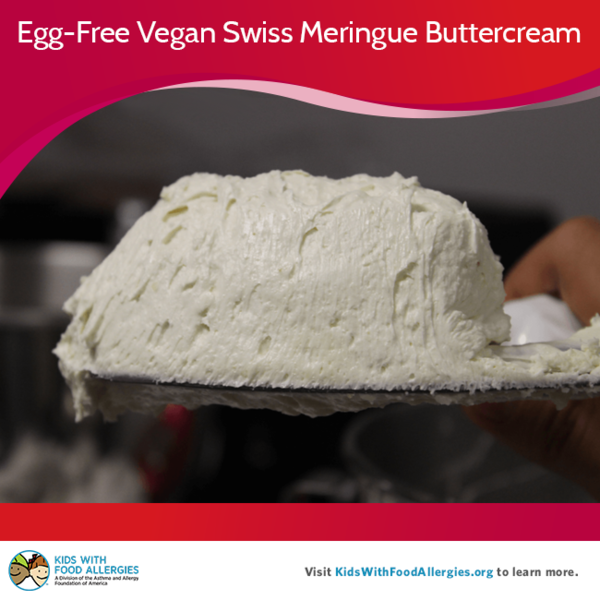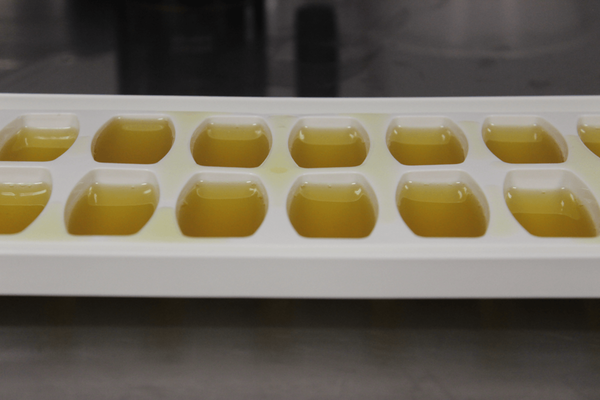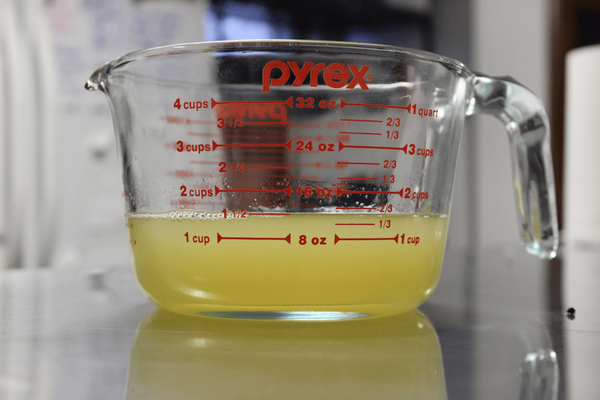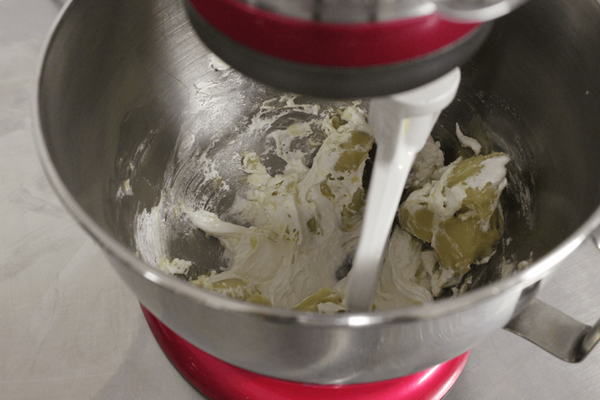Back in April, 2nd Generation Allergy Mom, AKA Eileen Rhoadarmer, introduced Kids With Food Allergies to the miracle ingredient that is Aquafaba. Never before has an ingredient so closely mimicked the chemical properties of egg whites. This comes as a relief to those with egg allergies who would still like to enjoy preparing recipes that use egg whites as a main ingredient.
The most obvious egg-free recipe to come out of the Aquafaba revolution is meringue, but at Loveletter Cakeshop, we push this ingredient one step further when preparing our vegan wedding cakes: Swiss meringue buttercream.

How many times have you cut into a slice of cake, taken a bite, and were sickened by the cloyingly sweet frosting spread in between each layer? It puts you off from wanting to eat the rest, doesn't it?
This is where European buttercreams shine. Instead of simply mixing powdered sugar and butter (or worse, Crisco), European buttercreams—Italian, Swiss, and French—use an egg white meringue to add creaminess and stability to the buttercream, while cutting much of that excess sweetness. What you get is a rich, fluffy buttercream that you can eat by the spoonful.
So, it's only fitting that we let Aquafaba do its magic and help create a European-style buttercream—in this case, Swiss. We like Swiss buttercream because it has more body than the other two versions and holds up very well under the weight of wedding cakes. If you're accustomed to making French or Italian Meringue Buttercream, Aquafaba will also work just fine.
Please note that the recipe below is for a completely vegan buttercream—no eggs, no dairy, no animal products of any kind. If you simply wish to eliminate eggs but prefer to use real butter, that will also work perfectly fine with the recipe below. Just be sure to add the room temperature butter slowly to the meringue until you've reached the texture you desire.
Alright, enough background, already! Let's get right to it, shall we?
Loveletter Cakeshop's Vegan Swiss Meringue Buttercream
INGREDIENTS
1.5 cups Aquafaba (the liquid from approximately two cans of chickpeas)
3/4 cups granulated sugar
1/2 tsp cream of tartar (optional)
1 cup (220g) food grade, deodorized cocoa butter (melted)
1 cup (220g) palm oil (melted)
A splash of soy/almond/rice milk
1 or 2 large ice cube trays
STEPS
- Gently melt the cocoa butter and palm oil in separate bowls by placing the bowls over hot water.
- When oils have fully melted, pour one oil into the other and whisk with a fork until combined.
- Pour your oil into an ice cube tray and pop in the freezer immediately.

- Sift your sugar and cream of tartar and set aside.
- Reduce the Aquafaba on the stove on medium high until it has reached 25% of its original weight. This will take about 15-20 minutes. You can eyeball this if you'd like, but I highly recommend you use a scale, or at the very least, a measuring cup.

- Once the Aquafaba has been reduced, add your sugar and cream of tartar immediately and mix thoroughly. The smoother your mixture at this point, the smoother your buttercream will be.
- Whip your Aquafaba mixture for 5-7 minutes (stand mixer is best), or until stiff. It's difficult to overwhip, so if you're not sure, just keep whipping!

- Open your freezer and lightly touch your oil mixture. If it gives at all, keep it in the freezer. If it's rock solid to the touch, remove from the freezer and let it sit at room temperature.
- Alright, now this is the tricky part. There's just one thing left to do, and that's combining the oil with the meringue. If you throw in your rock-solid oil cubes right now, you'll have a soupy mess because the cubes won't incorporate and you'll be left with a chunky, soupy mess. If you wait too long and the oil becomes too soft, well...you'll end up with a chunkless, soupy mess.
My indicator of when the oil is ready to throw in is at the very first instant when you're able to make a large dent into the cube with your finger. Since all rooms are at a different temperature, it's impossible for me to tell you exactly how long this will take, but you're looking at approximately 20-30 minutes of thawing before you've reached this point. This is fine because your meringue will need to reach room temperature before you add in the oil anyway. Practice will make perfect with this step, and I highly recommend that you throw in just 2 or 3 cubes the first time you make this recipe, just in case you've made a mistake. Once you've learned how long to wait, you can proceed to make the entire recipe.

- If your buttercream is too thick or if it becomes too solid at room temperature, add your milk very slowly until you've reached the consistency you want.
NOTES
- I know what you're thinking: where the heck am I supposed to find food grade, deodorized cocoa butter? I buy mine here, but you can find plenty of food grade cocoa butter on Amazon and perhaps even at your local health food store. You absolutely must make sure you're buying food grade cocoa butter, and unless you want a strong white chocolate flavor in your buttercream (which is also delicious), make sure to buy deodorized.
- The cream of tartar is optional, but recommended. It helps to add stability to your meringue and will help prevent it from collapsing on you. I've read of people making this recipe without using cream of tartar.
- You can store this buttercream in the fridge or freezer. If consumed within a few hours, no need to refrigerate a frosted cake. But any longer than that, then we'd recommend refrigerating.
- You can store this buttercream in the freezer for several months. To use: remove from freezer to fridge overnight, bring to room temperature, then re-whip. I should mention that cocoa butter and palm shortening have a narrower temperature window of usability than dairy butter.
- If you plan to store a buttercream-filled cake in the fridge/freezer, you will need to precisely measure the amount of soy/almond/rice milk you add at the end of the recipe to ensure proper consistency when brought back to room temperature. Assuming correct ratios, then you can fill and freeze your finished cake. Just be sure the cake comes FULLY back down to room temperature. If you need to widen this temperature window, omit the cocoa butter and use straight palm shortening. In my opinion, however, this results in a flatter flavor.
- If you'd like to skip the cocoa butter altogether, it's fine to just use palm shortening, but you'll face a few issues. One, it won't taste as good. Two, it won't feel as good on your palate since it's greasier than cocoa butter. Third, you might run into texture issues, unless you thicken your buttercream through other means
- This recipe makes approximately 750 grams of buttercream. This should be enough to frost a 2- to 4-layer, 8- or 9-inch cake or 24 cupcakes.

BRANDON BAKER
Owner, Head Chef, Cake Whisperer, Loveletter Cakeshop
Born in New York City, Brandon has always had a fascination with the chemistry of food. After graduating from the University of Pennsylvania with a degree in Evolutionary Psychology, he moved back to New York and put his passion to work. His mathematical mind and (often irrational) obsession with the kitchen scale drives everyone crazy, but the results are worth it.






Comments (5)